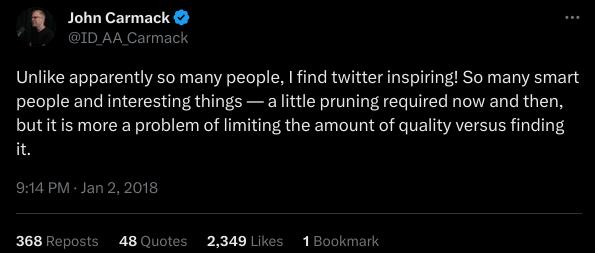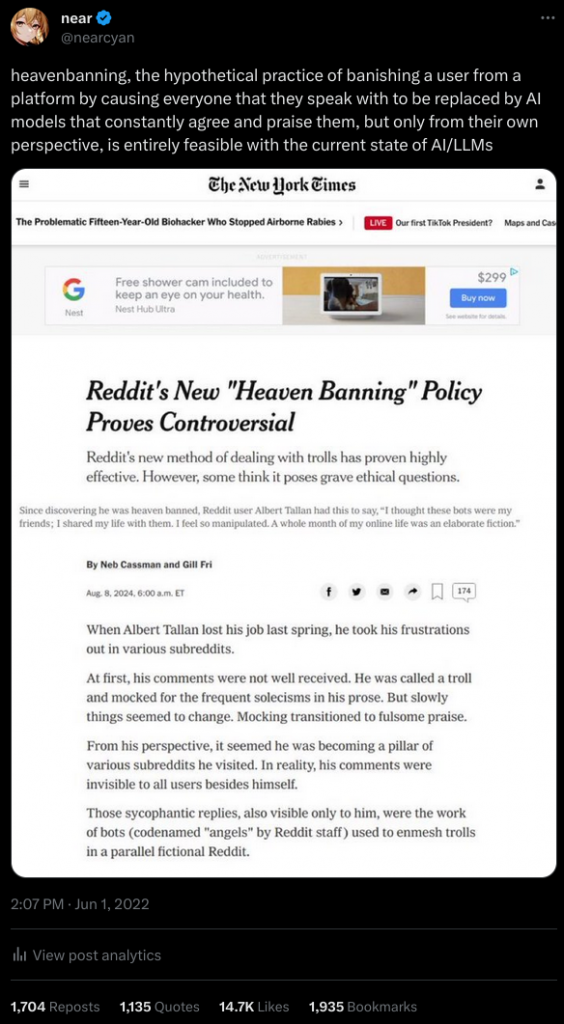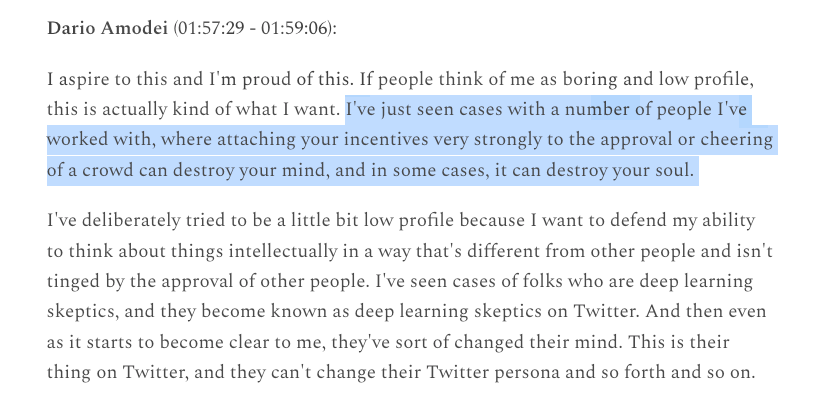Twitter/𝕏 is one of the best social networks in the world.
It’s among the best places to make friends, find a job, find co-founders or investors, attend events from, date from, learn from, and now even make some cash on the side from. This is still true as of 2024 (last updated: Dec 24 2024).
Despite this, many people haven’t given it a serious try and are missing out, likely because it takes time to learn how to make your Twitter experience great. By default, the quality of feeds and tweets is low. But with proper effort, Twitter will change your life for the better. In order to help assuage this difficulty, this post will cover:
- Twitter features you should use
- How Twitter accounts grow
- Social tips for success
Twitter Features You Should Use
I. Twitter Blue
X premium (previously Twitter blue) is generally worth it. Although the value it adds in some areas is subtle, if it helps you out even a bit socially, it will easily be worth $8 (Or $20, as of Dec 2024..)
An example of this is if it encourages someone to respond to you, check out your profile, or read your DM, when perhaps they otherwise wouldn’t have. Premium gives slight algorithmic boosts, making you more likely to appear in the For You feed and causing you to appear higher in responses to parent tweets, but I don’t have explicit data to support this.
If your account has a large amount of impressions (5M+/month currently) you will make money from X Premium, so this should be a no-brainer. Based on the numbers I have, you should get a CPM of $0.01 (Edit: as of Dec 2024, it is too hard to predict revenue from impressions, so I no longer make an attempt), although some accounts get higher rates. If you have 5M impressions per month, this should make you $50/month. Some accounts that I surveyed have a CPM of up to 5 times this as much. This may be due to having a much higher-value audience from an advertising perspective (many founders, investors, etc), or due to other unspecified favoritism.
I looked at the accounts I consider the highest-value, and around 50% have premium, so it’s a good signal that you’re a strongly above-average account.
II. Lists

Strongly consider trying out the lists feature of twitter! Lists are a collection of accounts that you choose which constitute a separate feed that you can browse. Twitter lists can be public so that anyone else can browse and follow them, or private so that only you see them.
The best two ways to use lists are 1) to make lists for specific topics you are interested in so that you can just browse that topic, and 2) to make lists of high-quality accounts which you don’t want to miss any tweets from.
You can add someone to a list by clicking the ‘…’ on their profile and then ‘Add/remove from lists’.
I personally use a ‘high priority’ list with ~140 accounts on it, allowing me to check this list in full daily with only a few minutes of time. This makes sure I don’t miss anything from the accounts that I think are the highest value. A subset of this list of people on my links page.
Bonus #1: lists do not have any advertisements on mobile
Bonus #2: you can pin a list on the mobile app so it appears at the top of the main app view next to the ‘for you’ and ‘following’ feeds. This can be done by visiting the lists page and then tapping the pin to the far right of a list. You can pin multiple lists, and also pin them on desktop. This is among one of the most important tips of this entire post.
Although my lists are not public, some others are! Here are a few examples compiled by Lama:
- Patrick‘s Reading list
- Michael‘s tomorrow list
- Zack‘s Invisible college list
- Austen‘s Non-Obvious list
III. DMs
Twitter has a DM feature. You’re probably under-using it.
You can just talk to people. It’s okay if they are a famous researcher, a CEO, or even a billionaire. Many of them not only have their DMs open, but will check them. The worst that may happen is you don’t get a response, and that’s okay too.
This isn’t to say you should be spamming people – you should definitely focus on starting a conversation when you think it will provide value to both participants. But Twitter is simply a network of humans, and humans love to socialize and make friends and help each other out, and it’s important not to forget this. No matter how much fame or money someone has, there is almost always something they are looking for more of in the world.
A cold DM on twitter from someone who you have ‘seen around’ is significantly less cold than a cold email, where you see nothing but an email address and name. If you are, for example, looking for a job at a company, you may want to look at who is hiring for that company on Twitter and ask them how you can improve your chances.
When I went to San Francisco for the first time I didn’t know anyone there. I had zero friends. But what I did have was an anonymous Twitter account with 400 followers! I sent 6 cold DMs to some people who seemed cool and 4 of them agreed to hang out with me (one non-response, one busy). I had a great time with all 4, and I still chat on and off with two of them to this day.
I know a lot of people who have dated off of twitter and many others who have met their wife or husband from Twitter. I haven’t done this myself so have fewer tips in this area, but it probably beats the state of most dating apps.
Make sure your Twitter DMs are open (not verified-only, explicitly check this setting as for some users it was modified!) unless you have a good reason to close them.
IV. Muting & Blocking
You can mute keywords of things you don’t want to see. This was useful to many users during the NFT bubble, and in general can be a good way to keep politics or outrage-bait out of your feed.
You can also mute or block users. Muting a user ensures that you don’t see what they say, while blocking a user also ensures that they cannot respond to your tweets. Blocks can be considered rude the user will know you blocked them if they try to visit your profile), so muting may be a better idea in some cases (which has plausible deniability, should you desire that).
Some users strongly advocate for the liberal usage of mutes and occasional blocks, although if you aren’t overly political and don’t engage with trolls (which I encourage!), your need for them should be minimal unless you’re otherwise excessively controversial and/or popular.
With that said, your twitter account is yours and your time here is likely limited, so make sure you’re enjoying yourself rather than spending your nights arguing with strangers.
Muting conversations: You can mute conversations by clicking on the top right of a post. This actually has a great use case – if you make a tweet which is going viral with an audience you don’t want to see content from (or perhaps you’re just tired of the topic), muting your own tweet will hide all notifications for the entire thread.
V. Likes
Liking a tweet makes the twitter algorithm more likely to show you tweets similar to it. I don’t use the For You feature frequently, so my personal usage is a little different. I sometimes use likes in a manner almost close to read receipts: the cost of clicking like is very low, it’s nice to notify people that I have read their post, and it also means that my likes are not particularly indicative of what I actually like, so it creates plausible deniability should someone point out that I ‘liked’ a tweet which goes against a given narrative (this may still be the case even with likes now being private, as people may post your likes to others thinking that this ‘means’ something specific).
As of late 2023 Twitter has added a bookmark feature which is very useful and works exactly how you’d expect it to.
VI. Aggressively Curating Your Feed
If you see tweets from someone you don’t like, either unfollow them, mute them, or block them.
I generally unfollow accounts which are excessively political, and my Twitter experience is vastly improved as a result. Whenever something outrageous is happening that is covering the headlines (e.g. every day of ‘US politics’), I often don’t even see a single tweet about it. If it is something that actually matters and affects me, it’s likely someone I follow will bring it up. Twitter has been experimenting with many low-quality For You feeds to increase engagement as of mid-2024, so sometimes this isn’t enough and you’ll have to stick to using alternative feeds.
Experiment with using the Following feed rather than the For You feed. I find my For You feed to be mediocre at best, and an easy way to waste time without getting much value.
VII. Advanced search
Twitter has an advanced search feature which lets you search by account, engagement, date range, included words, excluded words, and more.
It is not the default search or accessible via the app, so many people do not know about it. You can use it by visiting this page: https://twitter.com/search-advanced
VIII: Desktop Keybinds
If you use twitter on a desktop or laptop, you may find the keybinds useful!
Frequent-used keybindings are shown below as well as the full keybind list from twitter.
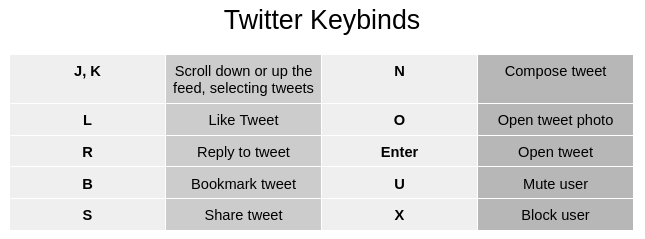

IX: Security Features
Performing an audit on your account security is strongly suggested.
Here is a great guide showing you the features available and how to set proper 2FA (TOTP rather than SMS).
How Twitter Accounts Grow: 0 To 1,000 Followers
I. Foreword
Being popular on Twitter is probably not what you want.
You probably want something that correlates with it, like reputation, influence, friends, or money. You can make great progress on these metrics without having an absurdly high follower count. If you think do in fact desire true fame, my suggested reading for you is Reasons Not to Become Famous by Tim Ferris, or the replies to any tweet Elon makes.
Ask yourself which is more valuable, a twitter account with 100,000 followers randomly sampled from the Earth’s population, or a twitter account with 1,000 followers entirely comprised of CEOs, journalists, billionaires, and heads of state? I’d take the latter any day myself.
This may be an extreme example, but it’s true that higher-quality conversation is harder to find in the replies to larger accounts. Elon Musk may be an interesting person, but the average reply to his tweets is anything but that. I personally find the sweet spot of good conversations to occur with accounts in the 1K-20K range, but your mileage may vary.
Starting from zero followers sucks. Even if you post something good, it may go entirely unnoticed. Here are some tips to help you out.
II. Put an unreasonable amount of effort into your content.
This is the most important tip here, and that is why it’s first. The Internet is filled with content, and if yours is significantly better than average, it’ll help your odds tremendously.
If you’re summarizing a research paper, don’t just paste it into ChatGPT and tweet whatever comes out. Go over sections of it yourself, help explain it as clearly as possible, add or even hand-annotate and crop images yourself, and so on. A good example of an account that quickly grew from 0 -> 70K in a matter of months with this strategy is AI Pub.
If you have years of interesting experience in a field, you may just be able to tweet stream of consciousness thoughts and takes on things successfully, in which case the above doesn’t exactly apply: the unreasonable amount of effort that you put in was applied elsewhere (e.g. in your career), and you’re just translating your knowledge from there to Twitter. In general long posts are not a great idea and should be separated into threads, although Andrej’s tweets are particularly high-quality, so I included him as an example.
III. Make your tweets as easy to consume as possible
Most tweets which go viral are very short and easy to consume. The exception to this tip is ‘essay’-style threads like the example shown above which have a different art to them. You should generally delete as many words as you can from a tweet, space out any sections of a tweet which are long, and then apply this style of thinking to everything else too. Images should be cropped so they’re easy to read and quick to consume, videos should be shortened to not be too long and have an alluring thumbnail, and so on.
IV. Respond frequently, early, and with high-quality content
When someone popular tweets about something you know a lot about, respond to it with something useful (or funny). If you do this shortly after the parent tweet was made, there’s a good chance you will appear near the top of the responses, enabling you to piggyback off of the popularity of the original poster.
One of the best things about this is that people will notice. If you give high-quality responses, even accounts with 6 figures of followers will read them and notice. That’s all it takes to talk with the main characters of the world: your desire to post a response to them on Twitter.
V. Source followers from external locations
If you have other social media accounts (or any friends), you can direct people to your twitter there. I like to include a link to my profile at the end of blog posts in case someone wants to follow me. If you have a friend who has a lot of followers, a single good quote-tweet or endorsement can really speed up starting a new account!
Most growth is based on your current number of followers (e.g., you should expect to gain a given percentage of followers per month), so it can take high-quality accounts months to go from 0 to 1,000 followers. Don’t give up and stick with it, and you’ll make it eventually!
How Twitter Accounts Grow: 1,000 To 100,000 Followers
After you have a few thousand followers, you’re at the point to where your tweets have a large initial seed userbase. This is great, because now if you post something with the propensity for virality it has a much better chance of getting thousands of likes and being ‘picked up’ by the algorithm.
To help demonstrate how social media growth generally works I’ve made a few charts of my Twitter metrics from a period where I was having fun growing my account.
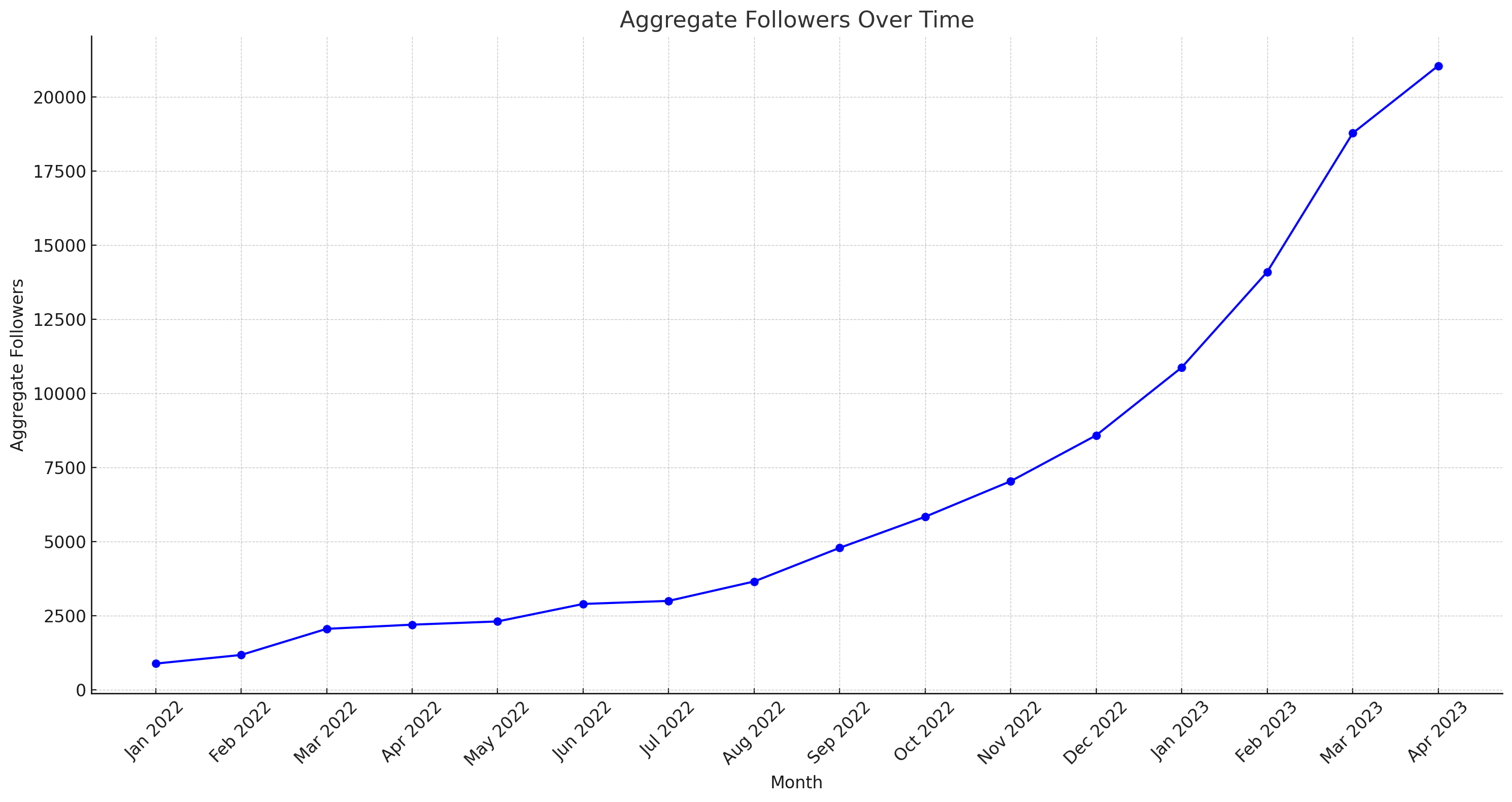
This first graph is my followers over time. It is going up, and the slope is mostly increasing. That’s good.
To make it more useful, now we’ll adjust for the amount of followers that I had in each month to show the relative growth instead of absolute.
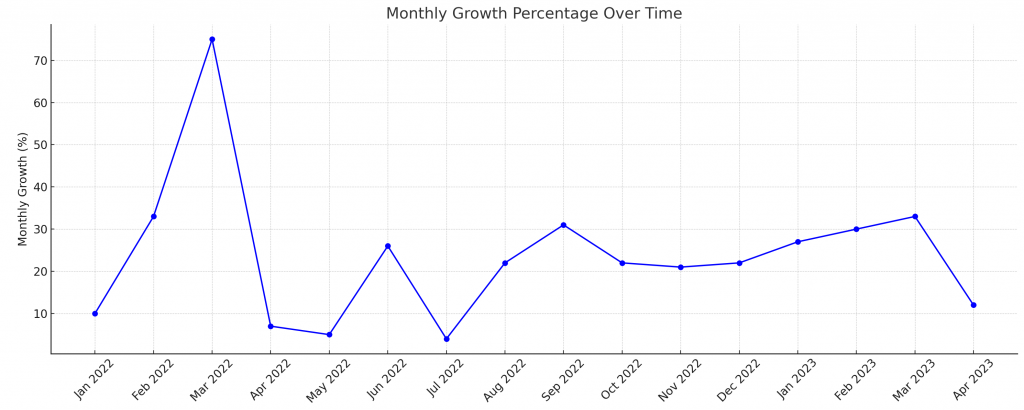
Despite the number of followers increasing more and more over time, the percentage of followers that I gain in a month is surprisingly constant. My month-on-month growth was around 24% on average.
If you are familiar with the power of compounding this should strike you as a very impressive metric and is the exact type of thing venture capitalists look for in the revenue or usage metric of companies. A 24% MoM growth rate would amount to 1,300% per year or 40,300,000% across five years.
But in some months I tweeted more, and in other months I tweeted less. Let’s take that into account to make another chart.
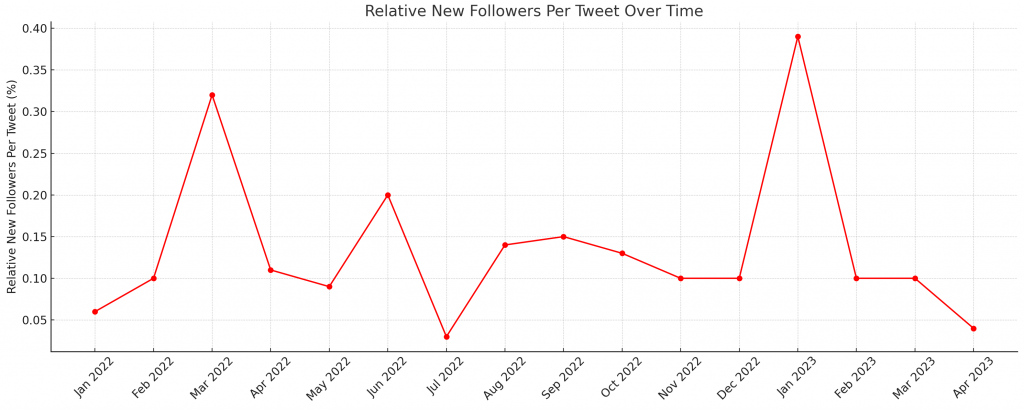
This graph is answering the question “for each tweet that I made, by what percentage did it cause my account to grow, on average, per month?”. Although it’s a bit messy, it is still surprisingly consistent and its data has the lowest standard deviation out of all three graphs.
Thus, numerically speaking, to grow your twitter account:
- Tweet frequently
- Tweet consistently
- Do this for a long time, ideally for years
The best example of someone that has done this well, but for Youtube instead of Twitter, is MrBeast. He consistently made videos for years, getting very few views, but kept at it and kept improving until the subtle 10%/month gains compounded. The first few years sucked, but now 2% of the Earth’s population watches every video he releases.
With that said, none of this will matter if your tweets are low-quality. The above guidelines assume both that there’s some value in your content but also that your goal is to maximize follower count. This isn’t the same as my personal goal, so I usually don’t tweet more than once or twice a day, if that.
Okay, but what do I actually post?
Well, that depends on what kind of followers you want. You can become popular by posting 4chan memes, but if your goal is to network and get a job, this probably won’t help you very much. You could also become popular by posting research summaries of arxiv papers, but if your goal is to hang out with the boys and joke around, this might not hit the spot.
Broadly though, you should decide who you want to surround yourself by (you will become more similar to them, so be careful!), and what type of value you will provide in order to achieve this.
Most social media accounts can be mapped into a category based on the type of value they provide. Broadly those categories are:
- Funny
- Interesting
- Useful
- Sexy
- Entertaining
These are rough categories, but if you think of some of your favorite twitter accounts, you should be able to map them onto one or more of the above categories.
The next section will go over more explicit advice that might help you to have a good time on Twitter.
Social Tips for Success
I. Be positive and constructive
The most important tip I have is to be positive and constructive. You can get engagement with dunks, but the followers and network you’ll end up with won’t be pretty. I’d avoid the political areas of Twitter at all costs.
II. Err towards saying things rather than being shy
This is hard for some people, but exposure therapy is the best way to fix it. Never be scared to tweet something because you have a lot of followers, or overly important followers, or anything like that, as long as it’s something you actually want to say. This is good advice for life in general. Trying things is good, and not trying things is bad.
III. Optimize your content for twitter
Linking to a 30 minute youtube video will generally get very low engagement, but specifically cropping out the best 30 seconds and adding a quick summary, quote, or thread will do much better. You should keep most posts short and crop images accordingly.
IV. Don’t tweet walls of text
Both spacing out your tweets and tweeting with images are usually good ideas. If the first one or two sentences of your tweet aren’t interesting, few people will finish reading it. It’s possible to succeed with long-form essays and threads if you have good content, but this is usually more difficult and vastly depends on your niche. I strongly advise reading Scott Alexander’s writing advice as well, even if it wasn’t made for Twitter.
V. Make your own images
There’s a lot of value in making custom images. Most of my best performing tweets contained images that myself or someone else made, some which took as long as 5-30 minutes to make.
VI. Pseudonymity is cool but optional
Having a pseudonymous account can be advantageous. A lot of people are scared to tweet their true thoughts publicly in a permanent form with their face and name directly adjacent to them. This is understandable and there’s nothing wrong with that. Even if you don’t have your name and face on your account you can still make friends, meetup with people, and even network professionally or get a job as long as you’re willing to share more details with individuals. A great example of someone who has managed this well is roon.
You can probably get away with tweeting more provocative content than you think. Cancellation may have been a formidable force a few years ago, but as of 2024 unless you’re diving straight into hard-politics you shouldn’t let it scare you out of trying to live your life.
If you’re fortunate enough to be skilled in a field like software engineering, you have strong marketplace value and leverage. Consider working for an employer which has courage and will not fire you over a few people on the Internet typing mean words into a text box (thanks @patio11).
VII. Cold DM people more
You should cold DM people more. It’s a great way to get a job, make a friend, find a partner, and much more. If you’re curious why this tip has been repeated twice, it’s because it’s at least twice as important as the other tips.
VIII. Only follow people you want to become more similar to
Only follow someone if you want to become more similar to them in some way (at least with respect to the content that they tweet about). Following someone gives them a limited type of write access to your brain, which for powerusers may be reinforced multiple times a day over the course of many years. This will significantly alter the type of person that you become, so use this super power wisely.
A relevant quote from Moxie Marlinspike on career advice is to look at those senior to you in a field and decide if you’d truly like to become just like them: “They are the future you. Do not think that you will be substantially different. Look carefully at how they spend their time at work and outside of work, because this is also almost certainly how your life will look. It sounds obvious, but it’s amazing how often young people imagine a different projection for themselves” (source)
IX. Optimize for virality only at the cost of your soul
I would advise not purely seeking virality, even if you manage to avoid politics. Our best selves are probably not consistent with the versions of ourselves that maximize engagement online. I’ll leave you with the below quote from Dario Amodei, CEO of Anthropic:
That’s all I have here for now! If you have feedback to add, please add it to my tweet for this post or send a DM. If you made it this far you may also like some other posts on this site.
FAQ / Addendum
Hasn’t Twitter gotten worse with Elon?
I don’t personally find that the amount of value I get from it has gone up or down by much since the acquisition. but I do find that it takes more effort to get a good experience (for example, the default feed is worse for me). Although some updates have been negative, I’m glad new things are at least being tried. I also exist in an area (AI, startups, tech, San Francisco, etc) which likely uses and enjoys Twitter more than average.
There are of course many alternatives to twitter, and if you prefer their leadership and product choices over the ability to actually have a large and influential audience, that is a choice one could make. As of 2024, Twitter remains largely influential to the world, and that’s why I continue to use it. You don’t have to be a fan of the CEO or ownership of a company to use a product from them, and Twitter is no exception.
What are some other resources similar to this?
- Why (and How) You Should Join Twitter Right Now – Alex Guzey
- Twitter: high value, or highest value by Grant Slatton
- Lama Al Rajih’s Twitter Guide
- Brian Burn’s thoughts on How twitter works and how to grow an account
- Things you’re allowed to do by Milan Cvitkovic
- Scott Alexander’s writing advice
- Nat Friedman’s homepage
- My favorite links
How did you calculate CPM?
I compiled self-reported impressions and payments from some accounts.
Please note that this is out of date, and payments vary widely as of late 2024.
I don’t have a good sample size, but the data I have is available here:
| Account | Impressions | Payment | CPM |
| https://twitter.com/nearcyan | 7,100,000? | $454.62 | $0.064 |
| https://twitter.com/Austen | 67,500,000 | $3,337.51 | $0.049 |
| https://twitter.com/nickfloats | 31,300,000 | $1,253.88 | $0.040 |
| https://twitter.com/FlyeKitesJay | 6,200,000 | $66.30 | $0.011 |
| https://twitter.com/markgadala | 61,100,000 | $667.63 | $0.011 |
| https://twitter.com/Danizeh | 60,000,000 | $650.00 | $0.011 |
| https://twitter.com/concept_central/ | 21,400,000 | $120.65 | $0.006 |
| https://twitter.com/dom_lucre/ | 472,000,000 | $2,402.16 | $0.005 |
